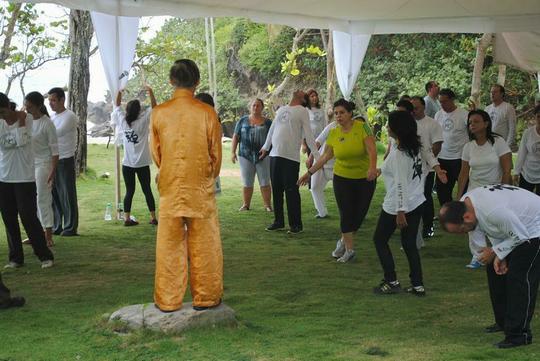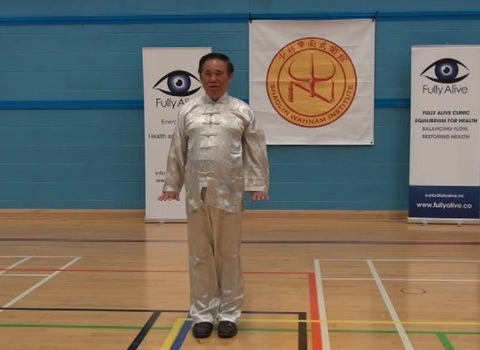TECHNIQUES, TACTICS AND STRATEGIES IN TEACHING VIPs

An effective strategy is to let VIPs want to learn from you
Question
VIPs are usually bosses or leaders who are set in their ways and used to instruct or give orders to subordinates or followers and thus may have difficulty to accept new material and to be on the receiving end of teaching. Although to shout to a King to bow lower in a stance seems a real challenge, we all know that Sigung Ho did teach kungfu to a King and Sifu has taught presidents and ministers successfully in the past .
May we get a glimpse of the techniques, tactics and strategies that Sifu will use to open the hearts of VIPs to transform them into good students for their own holistic good? What advise would Sifu give to our Instructors who may teach VIPs in the future?
Dr Damian Kissey
Answer
One of the requirements of a good teacher is using different techniques, tactics and strategies when teaching different groups of students. Teaching students who are mainly laborers and clerks is different from teaching students who are mainly managers and company directors, and it is different from teaching presidents, kings and royalties. While the teaching material as well as the principles in teaching and learning may be the same, the techniques, tactics and strategies to use in teaching the same material following the same principles to different groups of students are different.
The teaching material, which is the same for the different categories of students, may be classified into three categories for convenience. These three categories apply to both chi kung and kungfu, and are as follows.
- For health, which includes overcoming illness, and attaining vitality and longevity.
- For peak performance in daily life.
- For spiritual cultivation.
- Students must derive benefits from their learning.
- The teaching must be clear, systematic, and progressive.
- The teaching and learning must be fun.
In teaching students of the first group, like laborers and clerks, a teacher can be assertive. He gives instructions and expects his students to carry them out immediately. If the students hesitate, he can shout at them.
But it is inadvisable to shout at the second group of students, like managers and company directors, and unthinkable to shout at the third group of students, like presidents and kings. What should a good teacher do?
An effective strategy is to let these second and third categories of students know that it is to their benefit to follow the teacher’s instructions. If they do not follow the instructions, not only they do not derive the benefits the practice will give, their practice may be harmful.
The strategy is more effective if the students are also aware that following the instructions will fulfill their needs. They may do away with some benefits, but they may not do away with some needs. For example, it is beneficial to complete their work in 3 hours instead of 5, but if they do not have this benefit, they can still complete their work in 5 hours. However, if they suffer from a so-called incurable disease, they will die if they do not fulfill the need of overcoming the disease.
Managers and company directors are often sick with so-called incurable diseases, presidents may be stressful, and kings lacking in energy. The teacher can say politely but firmly that by following his instructions the managers and company directors can overcome their illness, the presidents can have mental freshness and clarity, and the kings can have vitality and longevity.
It is even more effective if the teacher can impress upon them, subtly but surely, that not only he can help them fulfill their needs but be may be the only one available to do so. This is true if we teach these very important people our chi kung or kungfu. As far as I know, no other teachers from other schools can provide the kind of benefits we do.
This strategy will work excellently if the very important people want to buy the teacher’s teaching, not the teaching selling it to them. In other words, it is the very important people who request the teacher to teach them. In my own experience, I have no problems at all teaching very important people. A very important reason is that they want to learn from me, not that I want to teach them.
Let us look at one or two examples to examine the techniques and tactics you can use for very important people. Suppose a company director suffers from diabetes, and he seeks your help to overcome his disease.
The technique you wish to teach him to generate an energy flow is “Carrying the Moon”. If he performs this technique correctly and be able to generate an energy flow, he will eventually overcome his diabetes as a matter of course. The tactic is to persuade him so that he will practice the techniques to generate an energy flow consistently to overcome his illness.
If you tell him in a commanding manner, “Practice this technique twice a day to generate an energy flow, and the whole training session is about 10 minutes,” he may do so in your presence but may not do so if you are not present. So, even when you have taught him the right techniques and transmit him the right skills, he may not succeed because you have not applied the right tactic and the right strategy.
However, if you gently tell him that his diabetes is not only causing him suffering, but also affects his family and his work negatively, but if he overcomes it, which is what he wants, he will not only overcome these problems but also gain many benefits. You assure him that by practicing the techniques consistently the way you have taught him, will overcome his diabetes as a matter of course.
You may explain to him the philosophy why practicing our chi kung will overcome his diabetes, using the philosophy of energy flow clearing energy blockage. You may also give him examples of many people overcoming diabetes by following our method. If you are new in chi kung healing and may not have sufficient examples to impress him, you can cite the examples of other instructors or cite my examples.
The strategy is to let him want to practice, not tell him to practice. The tactic is to tell him that the method has been proven and many people following this method have overcome diabetes.
Let us now take an example of a king lacking in energy, and he wants to practice chi kung to increase his energy.
If you teach the king the Horse-Riding Stance, the technique is not suitable. It may generate a lot of energy for other people whom you can shout at to practice the stance, but not the king. He may not have the patience and endurance to do so.
"Flicking Fingers" is a good technique because it produces a lot of energy in a very short time -- if the student practices it correctly.
Now you tell the king. "Flicking Finger is an exercise excellent for your majesty. Just follow me." The king tenses his muscles.
You tell the king, "Don't tense your muscles." But the king tenses his muscles again. You tell the king, "Just relax. Can you just relax?"
Not only you will not be successful in teaching the king, you may also create ill feeling between yourself and him. Your technique is correct, but your tactic in teaching him is not.
What should you do? Let us start with the right strategy. It is not telling the king what to do, but letting the king want to do what you teach him. The tactic is to tell the king politely so that he will not be antagonized but firmly so that he can follow your instructions.
If it is the king who looks for you, and not the other way round, you have already won half the battle in using the right strategy. The other half is to confirm that if the king follows your instructions, which he can do so comfortably, he will be sure to satisfy his need.
You may tell the king as follows. “Your majesty, Flicking Fingers is excellent for increasing energy that you need. But the important thing is not the technique, but how you perform the technique, i.e. the skill. I shall show you how to do it. All you have to do is just follow.”
Irrespective of whether you teach students whom you can shout at, or very important people like company directors or royalties, make the learning fun. When students enjoy what they practice, they will learn fast.

"Flicking Fingers" can produce a lot of energy
The questions and answers are reproduced from the thread 10 Questions on Special Chi Kung Course for VIPs.
LINKS
